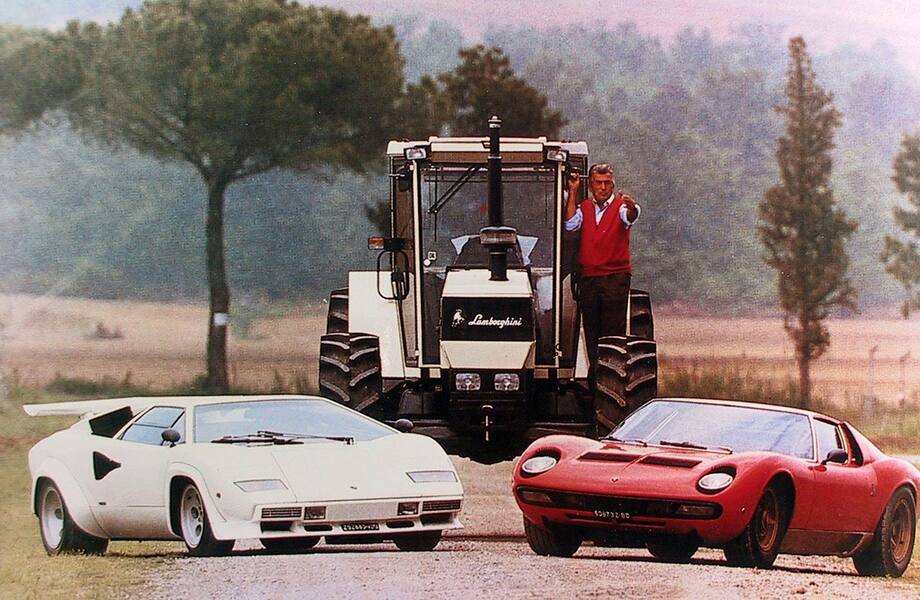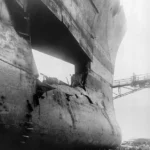The clash between Enzo Ferrari and Ferruccio Lamborghini sparked one of the most significant rivalries in automotive history. A heated argument over a faulty clutch in Lamborghini’s personal Ferrari led him to establish his own sports car company in 1963, directly challenging Ferrari’s dominance in the luxury automotive market.
Two Italian innovators with vastly different backgrounds shaped the future of high-performance vehicles. Enzo Ferrari built his legacy through racing, while Ferruccio Lamborghini made his fortune manufacturing tractors before venturing into sports cars.
Their competition drove both manufacturers to push engineering boundaries, resulting in iconic vehicles that set new standards for speed, design, and luxury. The rivalry continues to influence automotive excellence, with both brands representing the pinnacle of Italian engineering and style.
Origins of a Rivalry
The clash between Enzo Ferrari and Ferruccio Lamborghini stemmed from a heated exchange over a mechanical issue, transforming two Italian industrialists into fierce competitors in the luxury sports car market.
Enzo Ferrari’s Legacy
Born in Modena in 1898, Enzo Ferrari developed his passion for racing at age 10 after witnessing a race at Circuit di Bologna. His early career began as a test driver for C.M.N (Costruzioni Meccaniche Nazionali) in 1919.
Ferrari founded Scuderia Ferrari in 1929, initially serving as Alfa Romeo’s racing division. He built his first car, the 125 S, in 1947 after leaving Alfa Romeo.
His company quickly gained recognition for producing high-performance racing cars and exclusive road vehicles. Ferrari’s perfectionist nature and dedication to racing shaped his business approach.
Ferruccio Lamborghini’s Beginnings
Ferruccio Lamborghini started as a mechanic in the Italian Royal Air Force during World War II. After the war, he established a tractor manufacturing business using surplus military vehicles.
His mechanical expertise and business acumen led to remarkable success in the tractor industry. By the early 1960s, Lamborghini Trattori had become one of Italy’s largest agricultural equipment manufacturers.
Lamborghini owned several Ferrari cars but found them lacking in quality, particularly the clutch mechanisms. His complaints to Enzo Ferrari were met with dismissal, sparking his determination to create superior sports cars.
The Birth of Lamborghini Automobiles
Ferruccio Lamborghini transformed from a successful tractor manufacturer into a legendary sports car creator through a heated exchange with Enzo Ferrari in 1963.
The Story Behind the Bull
The Lamborghini brand adopted the fighting bull as its iconic symbol, inspired by Ferruccio’s zodiac sign, Taurus. He frequently visited Spanish bull breeder Don Eduardo Miura’s ranch, which later influenced the naming of one of Lamborghini’s most famous models.
As a wealthy industrialist, Ferruccio owned several luxury cars, including multiple Ferraris. His mechanical expertise from manufacturing tractors gave him unique insights into automotive engineering and quality.
Ferruccio’s Response to Ferrari
After experiencing recurring clutch problems with his Ferrari 250 GT, Ferruccio met with Enzo Ferrari to discuss the issues. Ferrari dismissed his complaints, suggesting he stick to driving tractors.
This dismissive encounter sparked Ferruccio’s determination to create superior sports cars. He established Automobili Lamborghini in 1963 in Sant’Agata Bolognese, Italy.
The first Lamborghini car, the 350 GT, debuted at the Turin Motor Show in 1964. It featured a sophisticated V12 engine designed by Giotto Bizzarrini, a former Ferrari engineer.
The 350 GT’s success proved Ferruccio’s capability to compete directly with Ferrari in the luxury sports car market.
Ferrari’s Motorsport Prowess
Ferrari’s racing legacy stands as a testament to engineering excellence and competitive spirit, with 16 Formula 1 Constructor Championships and 15 Driver Championships between 1950 and 2024.
Racing Dominance
Ferrari secured its first Formula 1 victory at Silverstone in 1951 with José Froilán González behind the wheel. The team’s golden era emerged in the 1950s, with Juan Manuel Fangio and Alberto Ascari clinching crucial victories.
Michael Schumacher’s era marked Ferrari’s most successful period, with five consecutive championships from 2000 to 2004. The team claimed 72 wins during this remarkable stretch.
Ferrari holds the record for most Grand Prix starts at over 1,000 races. Their distinctive Rosso Corsa red cars have competed in every Formula 1 season since the championship’s inception in 1950.
Innovation in Performance
Ferrari pioneered aerodynamic developments in F1, introducing the first rear wing at the 1968 Belgian Grand Prix. Their wind tunnel testing facilities in Maranello set industry standards.
The team developed groundbreaking technologies like the first semi-automatic gearbox in F1, debuted in 1989. Their innovative active suspension systems and traction control methods influenced modern racing.
Ferrari’s racing division serves as a testing ground for road car technology. Many features, including carbon-fiber construction and paddle-shift transmissions, transferred directly from race cars to production models.
Lamborghini’s Design and Engineering Ingenuity
Lamborghini revolutionized the supercar industry through groundbreaking design choices and engineering excellence that set new standards for performance and aesthetics.
Breaking the Mold
The Miura marked Lamborghini’s first major design breakthrough in 1966, featuring a mid-engine layout that transformed supercar architecture. Its transversely mounted V12 engine created a more compact and aerodynamic profile.
The distinctive scissor doors debuted on the Countach in 1974 became a Lamborghini trademark. This innovative door design solved the practical problem of visibility while parking and added dramatic flair.
Marcello Gandini’s angular designs for Lamborghini established a new visual language for supercars. His work on the Countach introduced the wedge-shaped profile and sharp lines that defined the brand’s identity.
Technical Milestones
Lamborghini pioneered the use of carbon fiber in production cars with the Countach Evoluzione prototype in 1987. This technology later became standard in their vehicles, significantly reducing weight while increasing structural rigidity.
The company developed sophisticated all-wheel-drive systems, first implemented in the LM002 and later refined in the Diablo VT. This technology improved handling and performance in adverse conditions.
The V12 engine architecture, refined over decades, achieved new heights with each generation. The original 350 GT’s V12 evolved from 270 horsepower to the Aventador’s 700+ horsepower while maintaining reliability.
Market Impact and Consumer Reception
The fierce competition between Ferrari and Lamborghini transformed the luxury sports car market, creating two distinct camps of enthusiasts and establishing new benchmarks for automotive excellence.
Brand Loyalty and Image
Ferrari cultivated an exclusive image through its racing heritage and limited production numbers. The company’s strict customer selection process and waiting lists added to its mystique, attracting wealthy collectors and racing enthusiasts.
Lamborghini positioned itself as the bold challenger, appealing to entrepreneurs and self-made success stories. Their cars featured more aggressive styling and cutting-edge technology, drawing buyers who sought to make a dramatic statement.
The rivalry sparked intense brand loyalty, with customers often developing strong emotional connections to their chosen marque. Ferrari owners praised the racing pedigree and tradition, while Lamborghini enthusiasts celebrated innovation and rebellion.
Cultural Icons
Both brands became synonymous with success and achievement in popular culture. Their vehicles appeared prominently in movies, music videos, and advertising campaigns throughout the 1960s and beyond.
Ferrari’s Prancing Horse and Lamborghini’s Fighting Bull emblems grew into globally recognized symbols of automotive excellence. Each logo carried its own meaning – Ferrari representing speed and grace, Lamborghini embodying power and aggression.
Celebrity ownership further elevated both brands’ status. Notable Ferrari enthusiasts included Steve McQueen and Miles Davis, while Lamborghini attracted Frank Sinatra and Dean Martin.
The distinctive engine sounds of both manufacturers became audio signatures, instantly recognizable to car enthusiasts worldwide.
Personal Affairs and Management Styles
Both automotive titans led their companies with distinct approaches, shaped by their individual backgrounds and personalities. Their contrasting management philosophies directly influenced their companies’ cultures and successes.
Enzo’s Leadership Approach
Enzo Ferrari maintained tight control over his company through an autocratic leadership style. He focused intensely on racing, often prioritizing motorsport success over road car production and profits.
His perfectionist nature led him to inspect every vehicle personally before it left the factory. Ferrari developed a reputation for being distant with his employees, preferring to communicate through intermediaries rather than direct interaction.
In meetings, he sat behind a large desk in his dimly lit office at Maranello, creating an atmosphere of authority and mystique. His employees addressed him as “Il Commendatore” – a title that reflected the formal, hierarchical structure he established.
Ferruccio’s Business Strategy
Lamborghini brought his practical experience as a successful tractor manufacturer to his automotive venture. He implemented modern production techniques and emphasized efficient manufacturing processes.
Unlike Ferrari, Lamborghini maintained an open-door policy with his engineers and workers. He regularly walked the factory floor, discussing technical details and suggesting improvements based on his mechanical expertise.
He focused on building luxury road cars exclusively, avoiding the expensive distraction of racing. This pragmatic approach allowed Lamborghini to maintain lower development costs and achieve profitability more quickly.
His hands-on management style fostered innovation among his engineering team. He encouraged creative solutions to technical problems, leading to groundbreaking designs like the Miura’s transverse engine layout.
Legendary Models: A Comparative Showcase
Both manufacturers produced iconic vehicles that defined their respective brands and shaped automotive history. Each company’s flagship models showcased distinct engineering philosophies and design approaches.
Iconic Ferrari Vehicles
The Ferrari 250 GTO, produced from 1962 to 1964, stands as one of the most valuable cars ever made, with only 36 units manufactured. In 2018, a 250 GTO sold for $48.4 million at auction.
The F40, introduced in 1987, marked Ferrari’s 40th anniversary with groundbreaking performance. Its twin-turbocharged V8 engine produced 478 horsepower, enabling a top speed of 201 mph.
The Ferrari Testarossa became a cultural icon of the 1980s with its distinctive side strakes and wide rear stance. Its flat-12 engine delivered 390 horsepower.
Lamborghini’s Hall of Fame
The Miura, launched in 1966, revolutionized supercar design as the first mid-engine road car. Its transverse-mounted V12 engine set new standards for performance and engineering.
The Countach’s wedge-shaped design and scissor doors transformed automotive styling from 1974 to 1990. Its aggressive angles and extreme proportions influenced supercar design for decades.
The Diablo carried Lamborghini through the 1990s as their flagship model. It was the first Lamborghini capable of exceeding 200 mph, powered by a 5.7-liter V12 engine producing 485 horsepower.
The Legacy and Future of Rival Supercars
The Ferrari-Lamborghini rivalry revolutionized the automotive industry, setting new standards for performance, design, and engineering excellence. Their competition sparked technological advancements that shaped the modern supercar landscape.
Influence on Modern Super Sports Cars
Ferrari and Lamborghini’s competitive spirit drove innovations in aerodynamics, engine design, and materials science. Their breakthroughs in carbon fiber construction and active aerodynamics are now industry standards.
Both brands pioneered hybrid powertrains in supercars, with Ferrari’s LaFerrari and Lamborghini’s Sián leading the charge toward electrification while maintaining exceptional performance.
Their distinctive design languages influenced countless manufacturers. Ferrari’s flowing lines and Lamborghini’s aggressive angles created two schools of supercar aesthetics that continue to inspire designers worldwide.
Ongoing Rivalry and Innovation
The competition between these Italian giants remains fierce in the 2020s. Ferrari’s 296 GTB and Lamborghini’s Revuelto showcase each brand’s unique approach to combining traditional performance with future-focused technology.
Both manufacturers are developing fully electric supercars while preserving their distinctive brand identities. Ferrari plans its first all-electric model for 2025, while Lamborghini aims for hybrid versions across its entire lineup by 2024.
Digital technology and connectivity features now play crucial roles in their vehicles, from advanced driver assistance systems to smartphone integration. Yet both brands maintain their focus on pure driving excitement and emotional appeal.
References
Ferrari S.p.A. (n.d.). History of Ferrari: From Racing to Road Cars. Retrieved from https://www.ferrari.com
Lamborghini Automobili S.p.A. (n.d.). The Origins of Lamborghini: Ferruccio’s Legacy. Retrieved from https://www.lamborghini.com
Levin, J. (2021). Ferrari vs. Lamborghini: The Greatest Rivalry in Automotive History. Car and Driver. Retrieved from https://www.caranddriver.com
Petrolicious (2017). How Ferruccio Lamborghini’s Feud with Ferrari Changed Supercars Forever. Retrieved from https://petrolicious.com
Parker, M. (2019). The Secret War Between Ferrari and Lamborghini. Top Gear. Retrieved from https://www.topgear.com
Matthews, J. (2022). From Tractors to Supercars: The Story of Ferruccio Lamborghini. MotorTrend. Retrieved from https://www.motortrend.com
Smith, T. (2023). The Most Iconic Ferrari and Lamborghini Models Ever Made. Road & Track. Retrieved from https://www.roadandtrack.com




